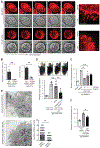Perivascular dendritic cells elicit anaphylaxis by relaying allergens to mast cells via microvesicles
- PMID: 30409859
- PMCID: PMC6376486
- DOI: 10.1126/science.aao0666
Perivascular dendritic cells elicit anaphylaxis by relaying allergens to mast cells via microvesicles
Abstract
Anaphylactic reactions are triggered when allergens enter the blood circulation and activate immunoglobulin E (IgE)-sensitized mast cells (MCs), causing systemic discharge of prestored proinflammatory mediators. As MCs are extravascular, how they perceive circulating allergens remains a conundrum. Here, we describe the existence of a CD301b+ perivascular dendritic cell (DC) subset that continuously samples blood and relays antigens to neighboring MCs, which vigorously degranulate and trigger anaphylaxis. DC antigen transfer involves the active discharge of surface-associated antigens on 0.5- to 1.0-micrometer microvesicles (MVs) generated by vacuolar protein sorting 4 (VPS4). Antigen sharing by DCs is not limited to MCs, as neighboring DCs also acquire antigen-bearing MVs. This capacity of DCs to distribute antigen-bearing MVs to various immune cells in the perivascular space potentiates inflammatory and immune responses to blood-borne antigens.
Copyright © 2018 The Authors, some rights reserved; exclusive licensee American Association for the Advancement of Science. No claim to original U.S. Government Works.
Figures





Comment in
-
Dangerous liaisons in anaphylaxis.Science. 2018 Nov 9;362(6415):640-641. doi: 10.1126/science.aav4505. Science. 2018. PMID: 30409871 No abstract available.
-
A Shocking Type of Communication.Immunity. 2018 Dec 18;49(6):999-1001. doi: 10.1016/j.immuni.2018.12.004. Immunity. 2018. PMID: 30566890
Similar articles
-
Large particulate allergens can elicit mast cell-mediated anaphylaxis without exit from blood vessels as efficiently as do small soluble allergens.Biochem Biophys Res Commun. 2015 Nov 6;467(1):70-5. doi: 10.1016/j.bbrc.2015.09.120. Epub 2015 Sep 26. Biochem Biophys Res Commun. 2015. PMID: 26410536
-
Integrin β1-mediated mast cell immune-surveillance of blood vessel content.J Allergy Clin Immunol. 2024 Sep;154(3):745-753. doi: 10.1016/j.jaci.2024.03.022. Epub 2024 Apr 16. J Allergy Clin Immunol. 2024. PMID: 38636606
-
A Shocking Type of Communication.Immunity. 2018 Dec 18;49(6):999-1001. doi: 10.1016/j.immuni.2018.12.004. Immunity. 2018. PMID: 30566890
-
Effector cells of anaphylaxis: mast cells and basophils.Novartis Found Symp. 2004;257:65-74; discussion 74-9, 98-100, 276-85. Novartis Found Symp. 2004. PMID: 15025392 Review.
-
Induction of Interleukin-10 Producing Dendritic Cells As a Tool to Suppress Allergen-Specific T Helper 2 Responses.Front Immunol. 2018 Mar 19;9:455. doi: 10.3389/fimmu.2018.00455. eCollection 2018. Front Immunol. 2018. PMID: 29616018 Free PMC article. Review.
Cited by
-
IgG Autoantibodies Against IgE from Atopic Dermatitis Can Induce the Release of Cytokines and Proinflammatory Mediators from Basophils and Mast Cells.Front Immunol. 2022 May 31;13:880412. doi: 10.3389/fimmu.2022.880412. eCollection 2022. Front Immunol. 2022. PMID: 35711458 Free PMC article.
-
Mast Cells: Fascinating but Still Elusive after 140 Years from Their Discovery.Int J Mol Sci. 2020 Jan 11;21(2):464. doi: 10.3390/ijms21020464. Int J Mol Sci. 2020. PMID: 31940755 Free PMC article.
-
Extracellular vesicles and nanoparticles: emerging complexities.Trends Cell Biol. 2023 Aug;33(8):667-681. doi: 10.1016/j.tcb.2023.01.002. Epub 2023 Feb 1. Trends Cell Biol. 2023. PMID: 36737375 Free PMC article. Review.
-
RAB22A sorts epithelial growth factor receptor (EGFR) from early endosomes to recycling endosomes for microvesicles release.J Extracell Vesicles. 2024 Jul;13(7):e12494. doi: 10.1002/jev2.12494. J Extracell Vesicles. 2024. PMID: 39051763 Free PMC article.
-
Extracellular Vesicles as Drug Delivery System for Cancer Therapy.Pharmaceutics. 2024 Aug 1;16(8):1029. doi: 10.3390/pharmaceutics16081029. Pharmaceutics. 2024. PMID: 39204374 Free PMC article. Review.
References
-
- Tejedor-Alonso MA, Moro-Moro M, Mugica-Garcia MV, Epidemiology of Anaphylaxis: Contributions From the Last 10 Years. J Investig Allergol Clin Immunol 25, 163–175; quiz follow 174–165 (2015). - PubMed
-
- Simons FE, O. World Allergy, World Allergy Organization survey on global availability of essentials for the assessment and management of anaphylaxis by allergy-immunology specialists in health care settings. Ann Allergy Asthma Immunol 104, 405–412 (2010). - PubMed
-
- Sampson HA et al., Symposium on the definition and management of anaphylaxis: summary report. J Allergy Clin Immunol 115, 584–591 (2005). - PubMed
Publication types
MeSH terms
Substances
Grants and funding
LinkOut - more resources
Full Text Sources
Other Literature Sources
Medical
Research Materials

